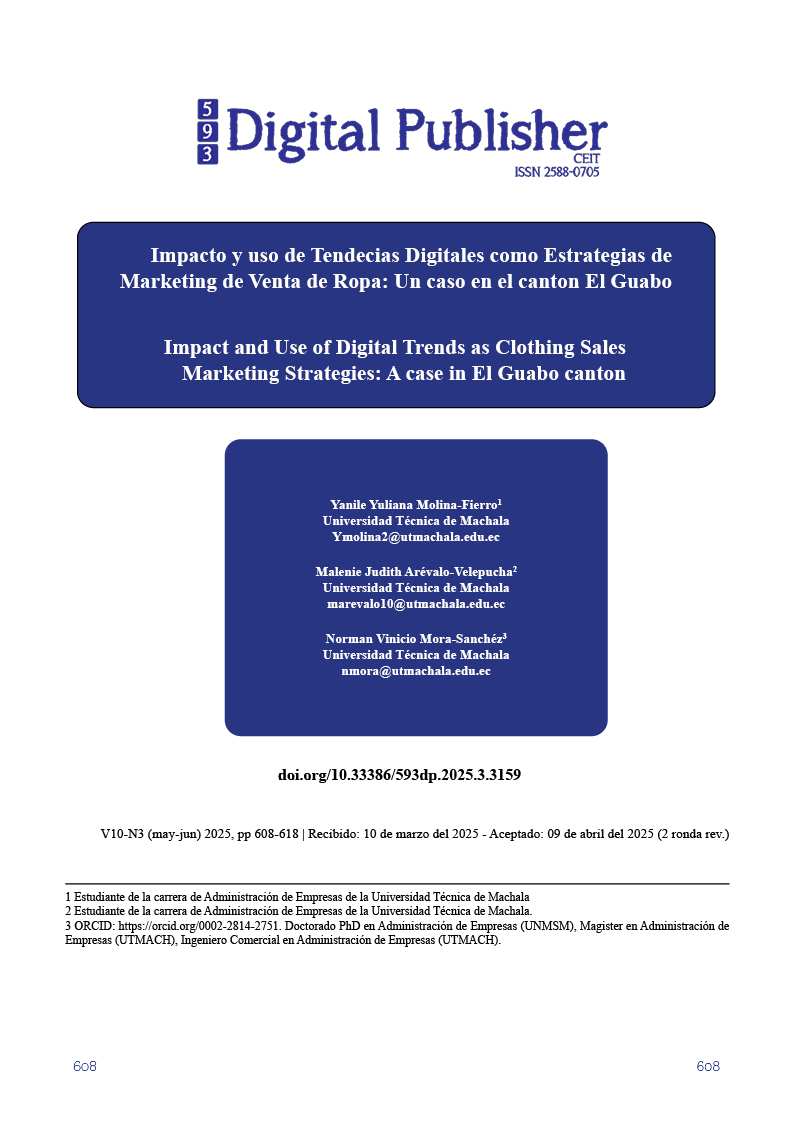Impact and Use of Digital Trends as Clothing Sales Marketing Strategies: A case in El Guabo canton
Main Article Content
Abstract
The four Fs of digital marketing “flow, functionality, feedback and loyalty” turn communication on digital resources into an attractive and effective experience. The purpose of this study is to assess the 4Fs of digital marketing in small and medium-sized companies in the El Guabo canton, El Oro Province, Ecuador, corroborating a measurement model and studying loyalty and the connection between these variables.
A qualitative, non-experimental, cross-sectional, descriptive and correlational research was carried out. Given the minimum number of participants, which consisted of 81 followers of the page and social networks. A 17-question survey was used, using confirmatory factor analysis with the maximum likelihood method to establish construct validity and reliability.
The study showed a high rating between the 4Fs of digital marketing and loyalty. All correlations have a significance level of 0.01 (two-sided). It is confirmed that the company's initiatives on its web pages to ensure that users enjoy a pleasant interaction and a simple and effective search for information, have a considerable impact on the dissemination of products and brands to the customer.
Downloads
Article Details

This work is licensed under a Creative Commons Attribution-NonCommercial-ShareAlike 4.0 International License.
1. Derechos de autor
Las obras que se publican en 593 Digital Publisher CEIT están sujetas a los siguientes términos:
1.1. 593 Digital Publisher CEIT, conserva los derechos patrimoniales (copyright) de las obras publicadas, favorece y permite la reutilización de las mismas bajo la licencia Licencia Creative Commons 4.0 de Reconocimiento-NoComercial-CompartirIgual 4.0, por lo cual se pueden copiar, usar, difundir, transmitir y exponer públicamente, siempre que:
1.1.a. Se cite la autoría y fuente original de su publicación (revista, editorial, URL).
1.1.b. No se usen para fines comerciales u onerosos.
1.1.c. Se mencione la existencia y especificaciones de esta licencia de uso.
References
Alcaide, J. C., Bernuès, S., Diaz Aroca, E., Espinosa, R., Muñiz, R., & Smith, C. (2013). Marketing y Pymes. Las principales claves de marketing en la pequeña y mediana empresas. Marketingypymesebook.
Celaya , J. (2011). La empresa en la web 2.0. En J. Celaya, LA empresa en la web 2.0; El impacto de las redes sociales y las nuevas formas de comunicacion online en la estrategia empresarial (pág. 39). Grupo Planeta: Gestion 2000.
Chaffey, D., & Ellis Chadwick, F. (2016). Digital Marketing : strategy, implementation and practice. En D. Chaffey, & F. Ellis Chadwick. Pearson.
Diaz Landero, V. C., Surdez Perez, E. G., & Reyes Cornelio, R. (2024). Modelos de 4Fs del marketing digital:vinxulo con el posicionamiento de marca. suma de negocios, 15(32), 50-58. https://doi.org/Doi: https://doi.org/10.14349/sumneg/2024.V15.N32.A6
Fleming, P., & Alberdi Lang, M. J. (2000). Hablemos del amrketing interactivo. En F. Paul, Reflexiones sobre marketing digital (pág. 219). ESIC .
Galicia Alarcon, L. A., Balderrama Trapaga, J. A., & NAvarro, R. E. (2017). Validez de contenido por juicio de expertos: propuesta de una herramienta virtual. Apertura, 9(2), 42-53. https://doi.org/https://doi.org/10.18381/Ap.v9n2.993
Gilvonio Yaranga, F. M., & Lapa Zarate, C. L. (2023). Implementation of Digital Marketing in Social Networks for the Brand Positioning of the Company Fima Industrial Manufacturer E.I.R.L. Investigacion e innovacion cientifica y tecnologia, 3(3), 50-58. https://doi.org/https://doi.org/10.54556/gnosiswisdom.v3i3.66
Gomez Reyes, S. L., Torres Duarte, M. C., & Tovar Gomez , A. M. (2018). La mezcla de mercadotecnia y su evolución a través del tiempo. Excelencia Administrativa, 15(44), 25-40. Obtenido de http://festivalgnu.fca.
Gomez Reyes, S. L., Torres Duarte, M. C., & Tovar Gomez, A. M. (2018). La mezcla de mercadotecnia y su evolución a través del tiempo. Excelencia Administrativa, 15(44), 25-40. Obtenido de http://festivalgnu.fca.uach.mx/posgrado_e_investigacion/2018/09/05/ExcelenciaAdministrativa-Vol-44.pdf#page=30
Iniesta Bonillo, M. A., Saèz Gonzalez, E., & Sanchez Perez, M. (2003). Estratégia Digital, Cómo usar las nuevas tecnologías mejor que la competencia. Esic Market, 115(2003), 149-178. Obtenido de https://dialnet.unirioja.es/servlet/articulo?codigo=623896
Leu Esquen, D., Marquina Montoya, X. A., & BArinotto Roncal, P. (2021). Influencia del marketing digital en la fidelizacion de los clientes de la empresa Kopish Pet Shop. Universidad&Ciencia, 10(2), 107-120. Obtenido de https://revistas.unica.cu/index.php/uciencia/article/view/1777/pdf
Martinez Polo, J., Martinez Sanchez, J. T., & Parra Meroño, M. C. (2015). MArketing digital. Guia para digitalizar tu empresas. UOC, Barcelona, 20(40), 171-174. https://doi.org/ http://dx.doi.org/10.15198/seeci.2016.40.171-172
Mattila, A. (2006). How Affective Commitment Boosts Guest Loyalty (and Promotes Frequent-guest Programs). CABI-Digital Library, 47(2), 174-181. Obtenido de http://cqx.sagepub.com/
NAFIN. (16 de 12 de 2024). www.nafin.com. Obtenido de https://www.nafin.com/portalnf/content/home/home.html: https://www.nafin.com/portalnf/content/home/home.html
Odilov, A., Gulomkhasanov, E., & Mulhammadieva, N. (2022). Digital Marketing. Uzbek Scholar Journal, 10(1), 5. Obtenido de https://www.uzbekscholar.com/index.php/uzs/article/view/345/324
Ortis Villareal, A. (2019). El marketing digital y la competitividad en el Centro Comercial MegaPlaza, Independencia. Universidad Cesar Vallejo. Obtenido de chrome-extension://efaidnbmnnnibpcajpcglclefindmkaj/https://repositorio.ucv.edu.pe/bitstream/handle/20.500.12692/34968/Ortiz_VAI.pdf
Ortiz, A. (2019). El marketing digital y la competitividad en el Centro Comercial Megaplaza. Independencia. Obtenido de https://repositorio.ucv.edu.pe/bitstream/handle/20.500.12692/34968/
Reinares, P. Y., & Ponzoa, J. M. (2008). “Improving management of multi-sponsor loyalty programmes based on the rewards preferred by consumers. Journal of Customer Behaviour, 7(2), 121-134.
Rendon, L. M., Osipina, Y., Palacios, M., Arcilla, C. A., & Bermeo, M. C. (2022). Factores perceptuales del uso del marketing en. Cuadernos Latinoamericanos, 18(35), 1-5. Obtenido de https://www.redalyc.org/
Ries, A., & Trucha, J. (2022). Position the Battle for Your Mind. En Posicionamiento: La batalla por tu mente (pág. 213). Libros Warner.
Rios Galarza, B. A., Anaya Carrasco, J. L., Gomez Zepeda, P. I., Alvarado Tarango, L., & Romero Gracias, A. (2023). Las herramientas de marketing digital que permiten alcanzar los objetivos de las PYMES: Una revisión de iteratura. IPSUMTEC, 6(1), 50-59. https://doi.org/https://doi.org/10.61117/ipsumtec.v6i1.174
Roehm, M. L., Bolman Pullins, E., & Roehm, H. A. (2002). Designing Loyalty-Building Programs for Packaged Goods Brands. American MArketing Association, 39(2), 202-213. https://doi.org/https://doi.org/10.1509/jmkr.39.2.202.19
Striedinger Melendez, M. P. (2018). El marketing digital transforma la gestión de pymes en Colombia. Cuadernos Latinoamericanos de Administracion, 14(27). Obtenido de https://www.redalyc.org/journal/4096/409658132001/html/
Valdes Cuero, A. A., Garcia Vazquez, F. I., Torres Acuña, G. M., Urias Murrieta, M., & Grijalva Quiñonez, C. S. (2020). Medición en Investigación Educativa con Apoyo del SPSS y el AMOS. En Medición en Investigación Educativa con Apoyo del SPSS y el AMOS (pág. 101). Clave Editorial.




